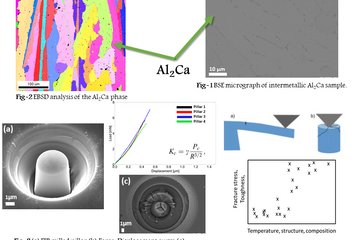All genres
401.
Talk
Microscopic and Submicroscopic Aspects of Delamination. ECASIA 2001, Avignon, France (2001)
402.
Talk
Investigation of the delamination of polymer-coated zinc and steel surfaces with the scanning Kelvin probe in a climatic cycle test. GALVATECH 2001, Brussels, Belgium (2001)
403.
Talk
Investigations into the Role of Copper in AA2024-T3 Aluminium Alloys on Filiform Corrosion Advancement and the Role of Chromium in Corrosion Inhibition. 63. AGEF-Seminar, Düsseldorf, Germany (2001)
404.
Talk
The Scanning Kelvin Probe as a New Technique to Analyze Buried Interfaces. 196th meeting of the ECS, Honolulu, USA (1999)
405.
Talk
Role of ammonia sulfate particles in the corrosion of electronic devices. Eurocorr'99, Aachen, Germany (1999)
406.
Talk
New ways for corrosion protection by organic surface modification. 191st Meeting of the ECS, Montreal, Canada (1997)
407.
Talk
On the influence of the electrode potential on growth and stability of thiol monolayer films: Scanning tunneling microscopic and electrochemical investigations. 3rd Indo-German Symposium on modern methods in electrochemistry, Bangalore, India (1996)
408.
Talk
Zum Einfluß des Elektrodenpotentials auf Wachstum und Zerstörung von Thiolfilmen. Bunsentagung, Jena, Germany (1996)
409.
Talk
The influence of the electrode potential on the self-assembly of decanethiol on the Au(111) surface. 188th Meeting of the ECS, Chicago, IL, USA (1995)
410.
Talk
Adsorption selbst-organisierter Mercaptan-Monolagen auf Gold. Workshop on Development and Industrial Application of Scanning Probe Microscopes SXM1, Münster, Germany (1994)
411.
Conference Report
6th international symposium Electrochemical Micro- and Nanosystem Technologies (EMNT 2006). EMNT2006, Bonn, Germany, August 22, 2006 - August 25, 2006., (2007)
412.
Poster
Characterization of electrochemical double layer formed on Au (111) electrode: a KPM, FTIR and APXPS investigation. 2nd Annual APXPS Workshop, Berkeley, CA, USA (2015)
413.
Poster
Transfer chamber from electrochemical cell to UHV. 79th Annual Meeting of the DPG and DPG Spring Meeting, Berlin, Germany (2015)
414.
Poster
Direct biocatalysis of methane from carbon dioxide by a lithtrophic archaeon. Electrochemistry 2014, Mainz, Germany (2014)
415.
Poster
Monitoring of anerobic microbially influenced corrosion via electrochemical frequency modulation. NACE Corrosion Conference 2014, San Antonio, TX, USA (2014)
416.
Poster
Direct electron uptake by sulfate-reducing bacteria in microbial corrosion of iron. Gordon Research Conference, Corrosion - Aqueous, New London, NH, USA (2014)
417.
Poster
Cathodes as the sole electron donors in cultures of corrosive SRB. Reservoir Microbiology Forum, London, UK (2013)
418.
Poster
Elektrochemisches Monitoring der mikrobiell beeinflussten Korrosion. GfKORR-Jahrestagung 'Untersucht, geprüft und dann... Lässt sich Korrosion vorhersagen?', Frankfurt, Germany (2013)
419.
Poster
Anaerobic Microbial Influenced Corrosion. 63rd Annual Meeting of the International Meeting of the International Society of Electrochemistry, Prague, Czech Republic (2012)
420.
Poster
Resistometry measurements to monitor abiotic and biogenic sulfide corrosion of iron. Engineering of Functional Interfaces EnFI 2010, Marburg, Germany (2010)











